Not so long ago, one of my photo-pals found a pink grasshopper.
To be very honest: his special find made me a little bit jealous.
After all it is just about the closest thing to a pink elephant!
At the same time, I realized how rare such a phenomenon actually is and how pointless to go out and look for one.
The chance of winning the lottery is greater.
So of course we started our Pink-Grasshopper-Mission.
With literally thousands of green brown brothers jumping around, I felt like I was looking for a needle in a haystack.
And just when I was about to give up, I noticed something pinkish!
I had found a Pink Grasshopper myself!
He wasn't very cooperative and despite his striking color he managed to escape within no time.
But boy, was that cool!
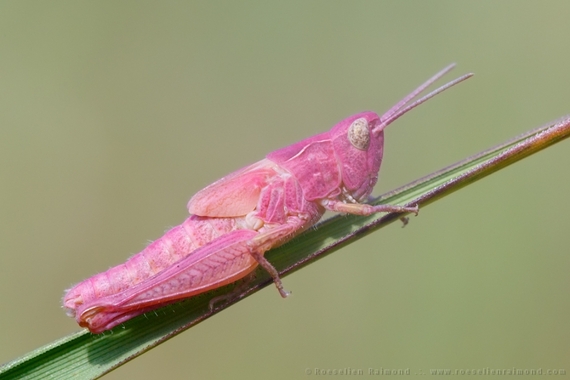
The Pink Hopper: about the closest thing to a pink elephant
Only little is known about pink grasshoppers, except that the color deviation is likely to be caused by the lack of black pigment (eumelanin) on one hand and on the other hand an excessive production of the red pigment (phaeomelanin).
This phenomenon is called erythrism and is defined as an unusual reddish discoloration of fur, hair, skin, feathers or egg shells.
The combination of red hair and freckles in humans is thought to be a form of erythrism, too.
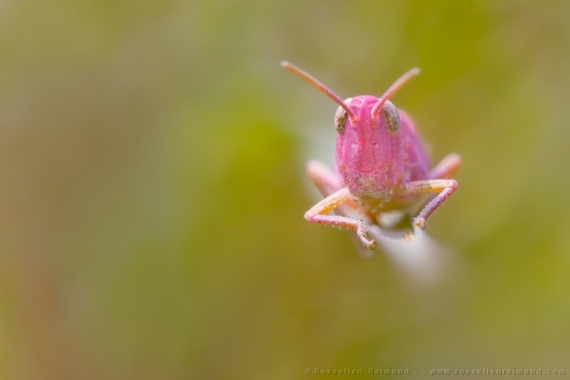
Erythrism: an unusual reddish discolouration of fur, hair, skin, feathers or egg shells
Erythrism is defined as an unusual reddish discolouration of fur, hair, skin, feathers or egg shells.
Albinism is characterized by the complete or partial absence of pigment in the skin, hair and eyes, resulting in partially or completely white hair or fur and red eyes.
In leucism the melanin is, at least partially, absent but the eyes retain their usual colour.
Melanism is the opposite of albinism. An unusually high level of melanin pigmentation results in an appearance darker than non-melanistic specimens from the same gene pool.
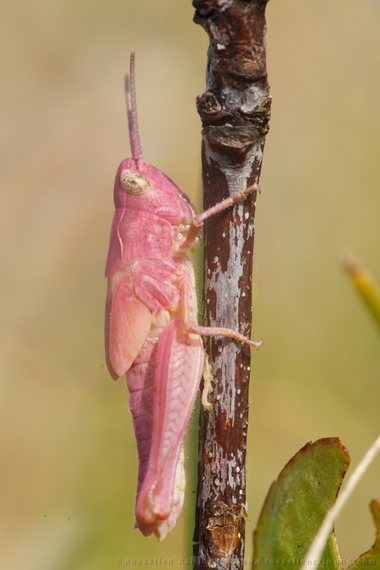
An excessive production of the red pigment
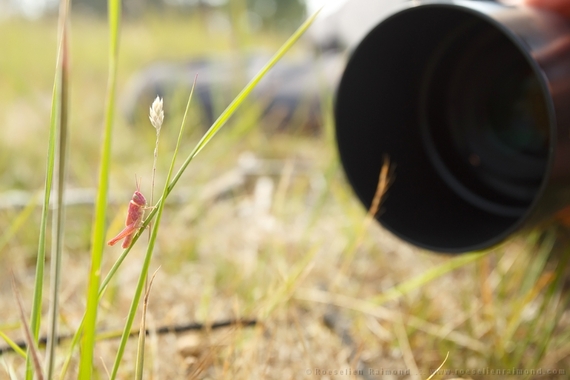
In a predominantly green area, being pink obviously is no benefit
Some theories claim that the gene for the pink color would be dominant in locusts, but that they simply don't reach maturity due to the vulnerability that comes with this pink color.
In a predominantly green area, being pink obviously is no benefit.
Another theory assumes that the pink gene is recessive.
Two parents with a latent pink gene are needed, to create a pink baby grasshopper.
Of course it's thinkable that the color pink would provide an advantage.
Like -for example- in a field of pink flowers.
In a case like this, the pink version would have an advantage over his green brothers and theoretically this could result in an entire pink population!
Imagine how happy would you be when you found that one very rare green one!
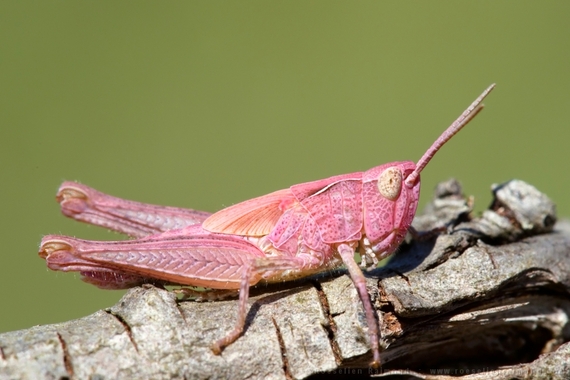
In a field of pink flowers, a pink version would have an advantage.
Theoretically this could result in an entire pink population!
Support HuffPost
Our 2024 Coverage Needs You
Your Loyalty Means The World To Us
At HuffPost, we believe that everyone needs high-quality journalism, but we understand that not everyone can afford to pay for expensive news subscriptions. That is why we are committed to providing deeply reported, carefully fact-checked news that is freely accessible to everyone.
Whether you come to HuffPost for updates on the 2024 presidential race, hard-hitting investigations into critical issues facing our country today, or trending stories that make you laugh, we appreciate you. The truth is, news costs money to produce, and we are proud that we have never put our stories behind an expensive paywall.
Would you join us to help keep our stories free for all? Your contribution of as little as $2 will go a long way.
Can't afford to donate? Support HuffPost by creating a free account and log in while you read.
As Americans head to the polls in 2024, the very future of our country is at stake. At HuffPost, we believe that a free press is critical to creating well-informed voters. That's why our journalism is free for everyone, even though other newsrooms retreat behind expensive paywalls.
Our journalists will continue to cover the twists and turns during this historic presidential election. With your help, we'll bring you hard-hitting investigations, well-researched analysis and timely takes you can't find elsewhere. Reporting in this current political climate is a responsibility we do not take lightly, and we thank you for your support.
Contribute as little as $2 to keep our news free for all.
Can't afford to donate? Support HuffPost by creating a free account and log in while you read.
Dear HuffPost Reader
Thank you for your past contribution to HuffPost. We are sincerely grateful for readers like you who help us ensure that we can keep our journalism free for everyone.
The stakes are high this year, and our 2024 coverage could use continued support. Would you consider becoming a regular HuffPost contributor?
Dear HuffPost Reader
Thank you for your past contribution to HuffPost. We are sincerely grateful for readers like you who help us ensure that we can keep our journalism free for everyone.
The stakes are high this year, and our 2024 coverage could use continued support. If circumstances have changed since you last contributed, we hope you’ll consider contributing to HuffPost once more.
Already contributed? Log in to hide these messages.





